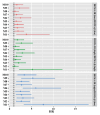Insulin Resistance and Impaired Insulin Secretion Predict Incident Diabetes: A Statistical Matching Application to the Two Korean Nationwide, Population-Representative Cohorts
- PMID: 39212039
- PMCID: PMC11525701
- DOI: 10.3803/EnM.2024.1986
Insulin Resistance and Impaired Insulin Secretion Predict Incident Diabetes: A Statistical Matching Application to the Two Korean Nationwide, Population-Representative Cohorts
Abstract
Backgruound: To evaluate whether insulin resistance and impaired insulin secretion are useful predictors of incident diabetes in Koreans using nationwide population-representative data to enhance data privacy.
Methods: This study analyzed the data of individuals without diabetes aged >40 years from the Korea National Health and Nutrition Examination Survey (KNHANES) 2007-2010 and 2015 and the National Health Insurance Service-National Health Screening Cohort (NHIS-HEALS). Owing to privacy concerns, these databases cannot be linked using direct identifiers. Therefore, we generated 10 synthetic datasets, followed by statistical matching with the NHIS-HEALS. Homeostasis model assessment of insulin resistance (HOMA-IR) and homeostasis model assessment of β-cell function (HOMA-β) were used as indicators of insulin resistance and insulin secretory function, respectively, and diabetes onset was captured in NHIS-HEALS.
Results: A median of 4,580 (range, 4,463 to 4,761) adults were included in the analyses after statistical matching of 10 synthetic KNHANES and NHIS-HEALS datasets. During a mean follow-up duration of 5.8 years, a median of 4.7% (range, 4.3% to 5.0%) of the participants developed diabetes. Compared to the reference low-HOMA-IR/high-HOMA-β group, the high-HOMA-IR/low- HOMA-β group had the highest risk of diabetes, followed by high-HOMA-IR/high-HOMA-β group and low-HOMA-IR/low- HOMA-β group (median adjusted hazard ratio [ranges]: 3.36 [1.86 to 6.05], 1.81 [1.01 to 3.22], and 1.68 [0.93 to 3.04], respectively).
Conclusion: Insulin resistance and impaired insulin secretion are robust predictors of diabetes in the Korean population. A retrospective cohort constructed by combining cross-sectional synthetic and longitudinal claims-based cohort data through statistical matching may be a reliable resource for studying the natural history of diabetes.
Keywords: Diabetes; Insulin resistance; Statistical matching; Synthetic data.
Conflict of interest statement
No potential conflict of interest relevant to this article was reported.
Figures




Comment in
-
Combining Nationwide Cohorts to Unveil the Predictive Role of Insulin Resistance and Impaired Insulin Secretion in Diabetes.Endocrinol Metab (Seoul). 2024 Oct;39(5):699-700. doi: 10.3803/EnM.2024.2189. Epub 2024 Oct 23. Endocrinol Metab (Seoul). 2024. PMID: 39476815 Free PMC article. No abstract available.
Similar articles
-
Relative contributions of insulin resistance and β-cell dysfunction to the development of Type 2 diabetes in Koreans.Diabet Med. 2013 Sep;30(9):1075-9. doi: 10.1111/dme.12201. Epub 2013 Apr 19. Diabet Med. 2013. PMID: 23600561
-
Serum uric acid to creatinine ratio as a predictor of insulin resistance, β cell function, and metabolic syndrome in normal Korean adults: a cross-sectional study.BMC Endocr Disord. 2025 Feb 5;25(1):31. doi: 10.1186/s12902-025-01860-0. BMC Endocr Disord. 2025. PMID: 39910480 Free PMC article.
-
Association of self-reported sedentary time with insulin resistance among Korean adults without diabetes mellitus: a cross-sectional study.BMC Public Health. 2018 Dec 4;18(1):1335. doi: 10.1186/s12889-018-6237-4. BMC Public Health. 2018. PMID: 30509229 Free PMC article.
-
The relationship between chronic kidney function and homeostasis model assessment of insulin resistance and beta cell function in Korean adults with or without type 2 diabetes mellitus.Endocr J. 2017 Dec 28;64(12):1181-1190. doi: 10.1507/endocrj.EJ17-0274. Epub 2017 Sep 9. Endocr J. 2017. PMID: 28890482
-
Big Data Research for Diabetes-Related Diseases Using the Korean National Health Information Database.Diabetes Metab J. 2025 Jan;49(1):13-21. doi: 10.4093/dmj.2024.0780. Epub 2025 Jan 1. Diabetes Metab J. 2025. PMID: 39828974 Free PMC article. Review.
Cited by
-
Combining Nationwide Cohorts to Unveil the Predictive Role of Insulin Resistance and Impaired Insulin Secretion in Diabetes.Endocrinol Metab (Seoul). 2024 Oct;39(5):699-700. doi: 10.3803/EnM.2024.2189. Epub 2024 Oct 23. Endocrinol Metab (Seoul). 2024. PMID: 39476815 Free PMC article. No abstract available.
-
Abnormal insulin metabolism and decreased levels of mindfulness in type 2 diabetes mellitus.Diabetol Metab Syndr. 2025 Jan 23;17(1):32. doi: 10.1186/s13098-025-01594-y. Diabetol Metab Syndr. 2025. PMID: 39849632 Free PMC article.
References
-
- Wang T, Lu J, Shi L, Chen G, Xu M, Xu Y, et al. Association of insulin resistance and β-cell dysfunction with incident diabetes among adults in China: a nationwide, populationbased, prospective cohort study. Lancet Diabetes Endocrinol. 2020;8:115–24. - PubMed
MeSH terms
Substances
Grants and funding
LinkOut - more resources
Full Text Sources

